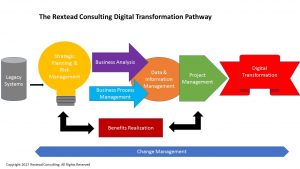
CEOs Need to Consider These Factors When Starting a Digital Transformation
By Marc Edwards, B.Sc. , PMP, Content Analyticss, bpms, MBA
Imagine you are a CEO/CAO/CIO in charge of your organization’s digital transformation. Here are some of the things you might see:
- The organization is way behind the digital transformation maturity scale
- The C-Suite may be older and are not familiar or comfortable with emerging technology.
- The C-suite can’t envision the company converting into a digital one.
- IT is in disarray and ill-equipped to deal with the onslaught of changes coming.
- There is no proper data management, business process management, or measurement of any kind other than the basic financial stuff.
- You’re unsure of the current internal support you have.
- The company as a whole has no real digital strategic vision with any focus on consumers.
- No one knows how to assign value to their data.
So how do you start? If you’re in charge of starting a digital business transformation, you will want to make sure you have a clear vision of the organization’s future, start a robust change management program from the beginning, hire and retain the right people, and identify the appropriate projects and outcomes that will allow you to reach your digital transformation targets.
You need a clear vision
Having a strong, clear vision is essential for any successful digital transformation. But what does that truly mean for you? Here, a bit of self-reflection is in order. As the CEO, you have to determine where your company is in the grand scheme of things and whether or not the company is ready for a digital transformation. But what does this mean? The questions you must answer are:
- Where are we on a digital transformation maturity scale?
- How do we use our data?
- Most, if not all, organizations will become data-driven, digital companies. Can you c-suite stakeholders envision and understand this?
- Can you, as the CEO, envision this as well?
If no is the answer to the last two questions, perhaps the entire c-suite, including you, is not the right group for the job and you need to get up-to-date immediately.
If yes is the answer to the last two questions, then great. But that’s not all. As the CEO, you must now plant the seeds to develop a new business model for your organization; one that revolves around the client experience.
You need to implement change management NOW
As a digital transformation leader and implementer, your biggest hurdle will be the organization’s corporate culture. One of the most effective methods of leaping over that hurdle is to establish a robust change management program from the beginning. Timing is important because such a massive change will require a continual, consistent message of the changes that will come and their impact upon the organization, making sure to emphasize any benefits.
What many will tell you is that getting buy-in from the major stakeholders is very important. While this is true, it is only part of the story. What is even more important than the buy-in from stakeholders is their commitment, which can materialize as:
- Assigning dedicated resources to the digital transformation initiative;
- Acting as digital transformation champions throughout the departments;
- Taking responsibility for certain initiatives or projects derived from the corporate digital transformation strategy.
You need help; IT can’t do it alone
While change management is important to get both buy-in and commitment from staff, it might become apparent to you that additional skill sets and expertise from outside the organization may be required to successfully implement the business’ digital transformation. Your IT department only has enough resources to maintain the operational work, not to do that and a digital transformation on top of that, as I mentioned in a previous blog post. They. Will. Need. Help. This help could take the form of:
- The creation of an internal innovation or digital transformation group, to help foster innovation within the company;
- The use of a 3rd party vendor or consultant, like Rextead Consulting, who can provide knowledge and expertise to the changes going on within your industry and outside it, and guide how to shape your digital transformation strategy to meet and deal with those industry changes.
You need to determine the desired outcomes
There are some outcomes that you will need to determine to get the ball rolling on a digital transformation. A strong project management office (PMO), through prioritization, benefits realization, and portfolio management, can be used to develop an implementation roadmap to determine:
- The desired business outcomes;
- The digital transformation initiatives and projects that align with those business outcomes;
- The desired impact of project implementation on the business outcomes;
- A prioritized list of projects with realistic timelines.
A strong PMO can also be used for bringing a renewed focus on measurement throughout the organization via benefits realization.
Hopefully, this blog post doesn’t present itself as a simple rant, but if it does, please understand that I’m merely emphasizing that you, as a CEO, must appreciate the importance of a strong, clear digital transformation vision, a robust change management program, knowing when you need help and getting it, and the focus on business outcomes.
If you have any questions about this, please email me at marc@rexteadconsultingcom or contact me at http://rexteadconsulting.com/contact/.












